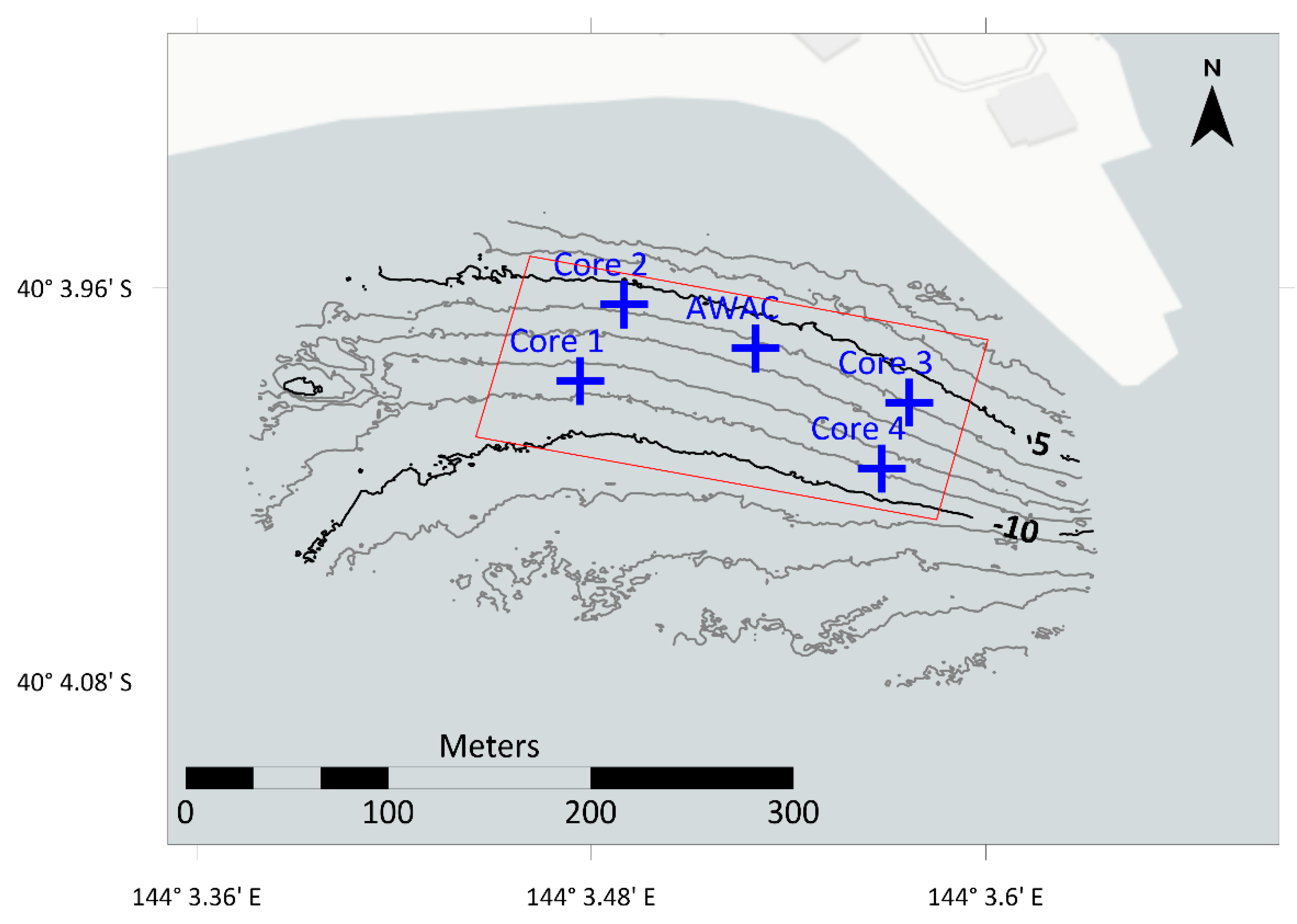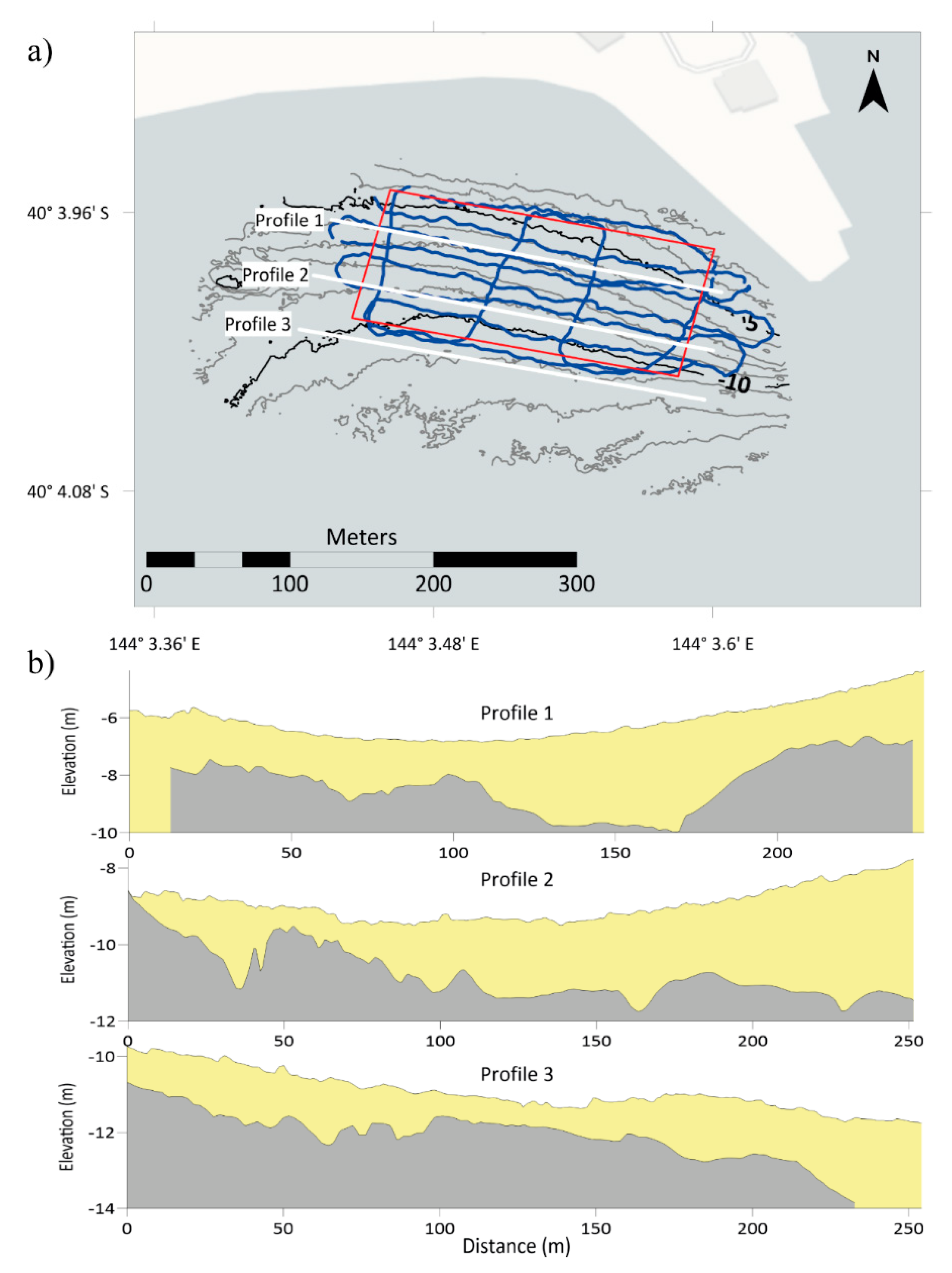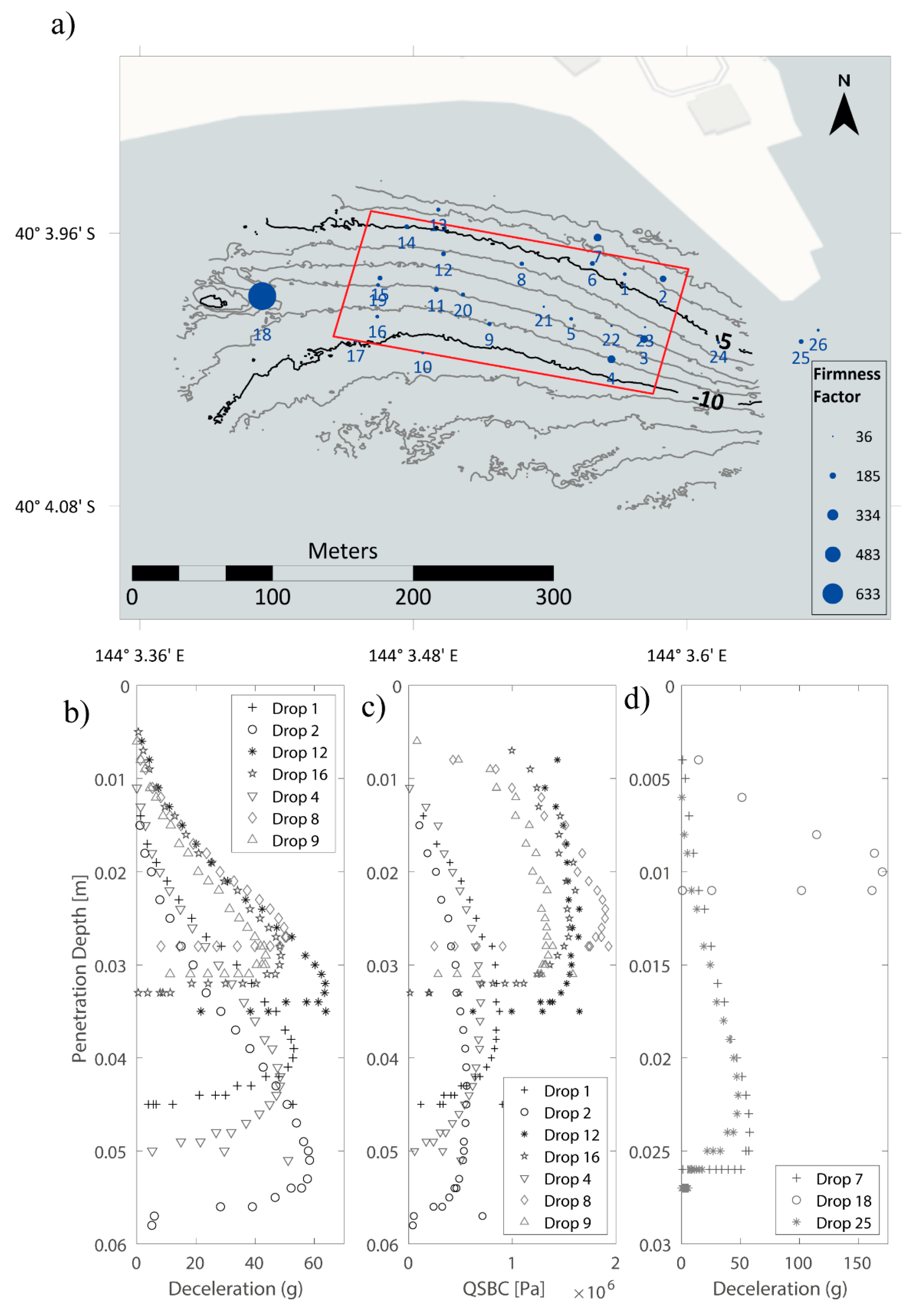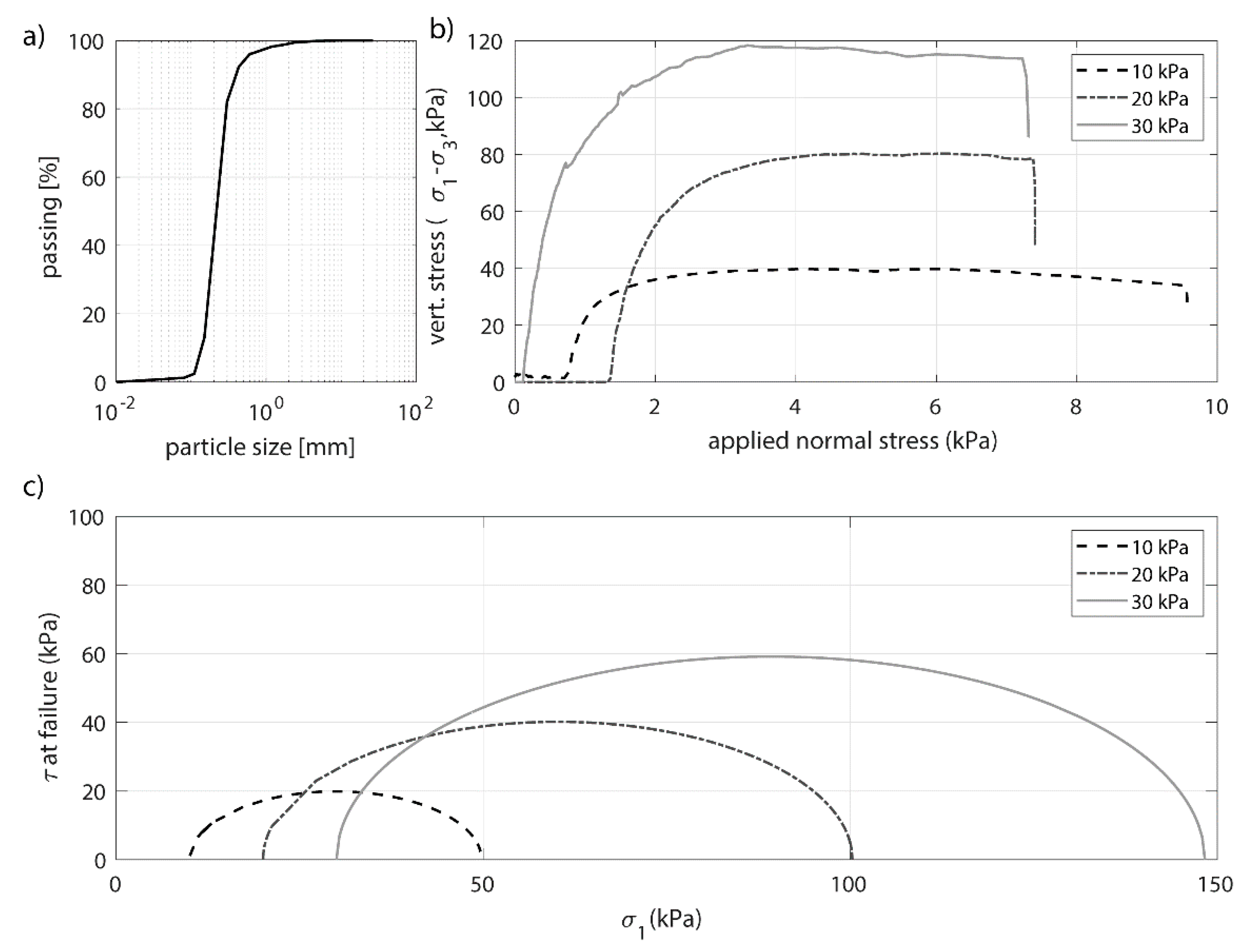Seafloor Site Characterization for a Remote Island OWC Device Near King Island, Tasmania, Australia
Abstract
1. Introduction
1.1. Challenges for OWC Site Assessments
1.2. Test Site and Energy Resource
2. Materials and Methods
3. Results
3.1. Cores
3.2. Sub-Bottom Profiling
3.3. Penetrometer
3.4. Geotechnical Analysis
4. Discussion
Author Contributions
Funding
Acknowledgments
Conflicts of Interest
References
- Hemer, M.; Griffin, D. The wave energy resource along Australia’s Southern margin. J. Renew. Sustain. Energy 2010, 2. [Google Scholar] [CrossRef]
- Enerdata. Global Energy Trends—2016 Report; World Energy Council 2016: London, UK, 2016. [Google Scholar]
- ABC-News. Huge Swell Sinks Wave Energy Generator; ABC-News: New York, NY, USA, 2010. [Google Scholar]
- Drew, B.; Plummer, A.R.; Sahinkaya, M.N. A review of wave energy converter technology. Proc. Inst. Mech. Eng. Part A J. Power Energy 2009, 223, 887–902. [Google Scholar] [CrossRef]
- Falcão, A.F.d.O. Wave energy utilization: A review of the technologies. Renew. Sustain. Energy Rev. 2010, 14, 899–918. [Google Scholar] [CrossRef]
- Iturrioz, A.; Guanche, R.; Armesto, J.A.; Alves, M.A.; Vidal, C.; Losada, I.J. Time-domain modeling of a fixed detached oscillating water column towards a floating multi-chamber device. Ocean Eng. 2014, 76, 65–74. [Google Scholar] [CrossRef]
- Ramsay, P. Supporting renewable energy projects using high resolution hydrographic and geophysical survey techniques, Garden Island, Western Australia. Underw. Technol. Int. J. Soc. Underw. 2016, 33, 229–237. [Google Scholar] [CrossRef]
- Goff, J.A.; Kraft, B.J.; Mayer, L.A.; Schock, S.G.; Sommerfield, C.K.; Olson, H.C.; Gulick, S.P.S.; Nordfjord, S. Seabed characterization on the New Jersey middle and outer shelf: Correlatability and spatial variability of seafloor sediment properties. Mar. Geol. 2004, 209, 147–172. [Google Scholar] [CrossRef]
- Brown, J. Available online: http://waveswellenergy.com.au/technology/ (accessed on 12 January 2020).
- Fleming, A.A.M.G.; Hunter, S.; Denniss, T. Power performance prediction for a vented oscillating water column wave energy converter with a unidirectional air turbine power take-off. In Proceedings of the 12th European Wave and Tidal Energy Conference, Cork, Ireland, 27 August–1 September 2017. [Google Scholar]
- Stark, N.; Hay, A.E.; Trowse, G. Cost-effective Geotechnical and Sedimentological Early Site Assessment for Ocean Renewable Energies. In Proceedings of the 2014 Oceans—St. John’s, St. John’s, NL, Canada, 14–19 September 2014. [Google Scholar]
- Barrie, J.V.; Conway, K.W. Seabed characterization for the development of marine renewable energy on the Pacific margin of Canada. Cont. Shelf Res. 2014, 83, 45–52. [Google Scholar] [CrossRef]
- Chatzigiannakou, M.A.; Dolguntseva, I.; Leijon, M. Offshore Deployments of Wave Energy Converters by Seabased Industry AB. J. Mar. Sci. Eng. 2017, 5, 15. [Google Scholar] [CrossRef]
- Chen, L.; Lam, W.-H. Methods for predicting seabed scour around marine current turbine. Renew. Sustain. Energy Rev. 2014, 29, 683–692. [Google Scholar] [CrossRef]
- Schneider, J.; Maynard, M.L.; Senders, M. Geotechnical engineering for offshore wind turbine foundations. Sea Technol. 2010, 51, 29–33. [Google Scholar]
- Cossu, R.; Heatherington, C.; Grinham, A.; Penesis, I.; Hunter, S. A cost-efficient seabed survey for bottom-mounted OWC on King Island, Tasmania, Australia. AWTEC 2018 Proc. 2018, 411–420. [Google Scholar]
- Fitzgerald, M.; Elsworth, D. Evolution of the Pore-Pressure Field Around a Moving Conical Penetrometer of Finite Size. J. Eng. Mech. 2010, 136, 263–272. [Google Scholar] [CrossRef][Green Version]
- Stark, N.; Wilkens, R.; Ernstsen, V.B.; Lambers-Huesmann, M.; Stegmann, S.; Kopf, A. Geotechnical Properties of Sandy Seafloors and the Consequences for Dynamic Penetrometer Interpretations: Quartz Sand Versus Carbonate Sand. Geotech. Geol. Eng. 2012, 30, 1–14. [Google Scholar] [CrossRef]
- Stoll, D.; Sun, Y.-F.; Bitte, I. Seafloor Properties From Penetrometer Tests. Ocean. Eng. IEEE J. 2007, 32, 57–63. [Google Scholar] [CrossRef]
- Mulukutla, G.K.; Huff, L.C.; Melton, J.S.; Baldwin, K.C.; Mayer, L.A. Sediment identification using free fall penetrometer acceleration-time histories. Mar. Geophys. Res. 2011, 32, 397–411. [Google Scholar] [CrossRef]
- Stark, N.; Kopf, A.; Hanff, H.; Stegmann, S.; Wilkens, R. Geotechnical investigations of sandy seafloors using dynamic penetrometers. In Proceedings of the OCEANS 2009, Biloxi, MS, USA, 26–29 October 2009; pp. 1–10. [Google Scholar]
- Bjerrum, L. Problems of soil mechanics and construction on soft clays and structurally unstable soils-collapsiable expansive and others. Int. J. Rock Mech. Min. Sci. Geomech. Abstr. 1975, 12, A19–A20. [Google Scholar] [CrossRef]
- Hansen, J.B. A revised and extended formula for bearing capacity. Danish Geotech. Inst. Bull 1970, 98, 5–11. [Google Scholar]
- Toby Johnson, D.T. Grassy Harbour Wave Climate and Scour Assessment; Cardno: St Leonards, NSW, Australia, 2019. [Google Scholar]
- Ahmadian, R.; Falconer, R.; Bockelmann-Evans, B. Far-field modelling of the hydro-environmental impact of tidal stream turbines. Renew. Energy 2012, 38, 107–116. [Google Scholar] [CrossRef]
- Funke, S.W.; Farrell, P.E.; Piggott, M.D. Tidal turbine array optimisation using the adjoint approach. Renew. Energy 2014, 63, 658–673. [Google Scholar] [CrossRef]
- Ricci, P.; Rico, A.; Ruiz-Minguela, P.; Boscolo, F.; Villate, J. Design, modelling and analysis of an integrated mooring system for wave energy arrays. In Proceedings of the 4th International Conference on Ocean Energy, Dublin, Ireland, 19 October 2012; pp. 1–6. [Google Scholar]
- Project, A. Tidal Energy in Australia—Assessing Australia’s Tidal Energy Resource & Its Ability to Contribute to Australia’s Future Energy Mix. Available online: http://austen.org.au/ (accessed on 19 January 2020).
- Stark, N.; Kopf, A. Detection and quantification of sediment remobilization processes using a dynamic penetrometer. In Proceedings of the OCEANS’11 MTS/IEEE KONA, Waikoloa, HI, USA, 19–22 September 2011; pp. 1–9. [Google Scholar]
- Robertson, P.K. Soil classification using the cone penetration test. Can. Geotech. J. 1990, 27, 151–158. [Google Scholar] [CrossRef]
- Heath, J.E.; Jensen, R.P.; Weller, S.D.; Hardwick, J.; Roberts, J.D.; Johanning, L. Applicability of geotechnical approaches and constitutive models for foundation analysis of marine renewable energy arrays. Renew. Sustain. Energy Rev. 2017, 72, 191–204. [Google Scholar] [CrossRef]
- Howe, J.A.; Anderton, R.; Arosio, R.; Dove, D.; Bradwell, T.; Crump, P.; Cooper, R.; Cocuccio, A. The seabed geomorphology and geological structure of the Firth of Lorn, western Scotland, UK, as revealed by multibeam echo-sounder survey. Earth Environ. Sci. Trans. R. Soc. Edinb. 2015, 105, 273–284. [Google Scholar] [CrossRef]
- Shaw, J.; Todd, B.J.; Li, M.Z.; Wu, Y. Anatomy of the tidal scour system at Minas Passage, Bay of Fundy, Canada. Mar. Geol. 2012, 323, 123–134. [Google Scholar] [CrossRef]
- O’Halloran, N.L.B. Geotechnical Design Report; Cardno (NSW/ACT) Pty Ltd.: St Leonards, NSW, Australia, 2019; pp. 1–40. [Google Scholar]
- Lancaster, O.; Cossu, R.; Baldock, T. Experimental investigation into scour processes around a gravity based Oscillating Water Column Wave Energy Converter. Coast. Eng. 2020. submitted. [Google Scholar]
- Petersen, T.U. Scour around Offshore Wind Turbine Foundations. Ph.D. Thesis, Technical University of Denmark, Kongens Lyngby, Denmark, 2014. [Google Scholar]






| Site | Latitude | Longitude |
|---|---|---|
| site 1 | S40° 03’ 59.3″ | E144° 03’ 28.6″ |
| site 2 | S40° 03’ 57.9″ | E144° 03’ 29.4″ |
| site 3 | S40° 03’ 59.7″ | E144° 03’ 34.6″ |
| site 4 | S40° 04’ 00.9″ | E144° 03’ 34.1″ |
| site AWAC | S40° 03’ 58.7″ | E144° 03’ 31.8″ |
| Load No. | Vertical Stress σ1 | Radial Effective Stress σ1 |
|---|---|---|
| 1 | 45.43 | 6 |
| 2 | 95.29 | 15.5 |
| 3 | 143.34 | 25.5 |
© 2020 by the authors. Licensee MDPI, Basel, Switzerland. This article is an open access article distributed under the terms and conditions of the Creative Commons Attribution (CC BY) license (http://creativecommons.org/licenses/by/4.0/).
Share and Cite
Cossu, R.; Heatherington, C.; Penesis, I.; Beecroft, R.; Hunter, S. Seafloor Site Characterization for a Remote Island OWC Device Near King Island, Tasmania, Australia. J. Mar. Sci. Eng. 2020, 8, 194. https://doi.org/10.3390/jmse8030194
Cossu R, Heatherington C, Penesis I, Beecroft R, Hunter S. Seafloor Site Characterization for a Remote Island OWC Device Near King Island, Tasmania, Australia. Journal of Marine Science and Engineering. 2020; 8(3):194. https://doi.org/10.3390/jmse8030194
Chicago/Turabian StyleCossu, Remo, Craig Heatherington, Irene Penesis, Ryan Beecroft, and Scott Hunter. 2020. "Seafloor Site Characterization for a Remote Island OWC Device Near King Island, Tasmania, Australia" Journal of Marine Science and Engineering 8, no. 3: 194. https://doi.org/10.3390/jmse8030194
APA StyleCossu, R., Heatherington, C., Penesis, I., Beecroft, R., & Hunter, S. (2020). Seafloor Site Characterization for a Remote Island OWC Device Near King Island, Tasmania, Australia. Journal of Marine Science and Engineering, 8(3), 194. https://doi.org/10.3390/jmse8030194





